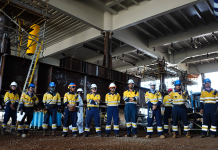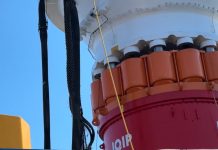Planned sites for wind turbine towers are sometimes underlain by loose, granular soils such as sands, gravels, or mine spoils, which can produce static, dynamic, and seismic foundation challenges. These challenges include excessive settlement, low bearing capacity, and liquefaction or lateral spreading. Densification of loose, granular material prior to tower construction is often the most cost-effective solution to address these issues. Densification methods include vibro-densification, vibro-displacement, compaction grouting, and dynamic compaction, described in this installment.
Dynamic compaction (DC)—also referred to as dynamic deep compaction and impact densification—is likely the oldest soil improvement process, with documented examples of DC used during Roman times. Thousands of sites have been treated with DC worldwide, including wind farms. The process consists of repeatedly dropping a heavy weight on the ground surface to impart stress waves to compact soils at depth. Typically, a standard crane is used to drop 5- to 30-ton weights from heights of 20 to 100 feet. Weights typically consist of hardened steel plated or box-steel and concrete. The impact points are distributed on 5- to 20-foot centers in a regular pattern determined by the subsurface conditions and the foundation loading and geometry beneath the foundation footprint and a perimeter area. Depending on the subsurface conditions and energy imparted to the soil, densification can be achieved to depths of 30 feet or more.
Although the process appears simple, experience is required to understand the capabilities, limitations, and risk factors associated with the DC technique. The soils that are most improved by DC are those with high permeability and low plasticity, including sand, gravel, some non-plastic silt, and granular mine spoil. The technique is also effective at densifying collapsible soils, which are soils found in the western U.S. that undergo large volume reductions when they become wet. Clayey soil, which deforms slowly with loading, is not a good candidate. In addition, thin clay layers within a granular profile can absorb the DC energy, preventing the energy transfer to underlying loose soils. A thorough geotechnical investigation is critical in determining the design parameters.
The depth of densification depends on the soil type and the energy applied. Repeated drops only increase the degree of densification within the treatment zone, not the depth of influence. To increase the treatment depth, the energy level must be increased by increasing the drop weight and/or drop height. Dynamic compaction densifies loose deposits of windblown sand at a planned wind power farm. Prior to selecting DC for ground improvement, existing nearby structures must be evaluated for vibration sensitivity. The ground vibrations associated with this technique can result in foundation settlement, slope instability, and adverse affects on vibration sensitive equipment and structures. For this reason DC is generally restricted to remote sites, a common feature of wind farm sites. As with every ground improvement project, a quality control program is essential to confirm that the required improvement has been achieved.
During the DC process the height, location, and number of drops are recorded, and crater depth, adjacent ground surface heave, and pore pressure are observed. After DC the degree of densification can be measured with standard penetration testing (SPT), cone penetration testing (CPT), pressuremeter testing (PMT), dilatometer testing (DMT), or other in-situ testing methods. The densification is permanent and the foundation design on DC improved soil is the same as if the soil were naturally dense. Determining the required weight, drop height, impact grid dimension, and number of passes is often the responsibility of specialty contractors, who rely on years of experience to determine the most efficient configuration. In addition, there are many safety issues associated with this technique, which are also addressed by the use of an experienced specialty contractor. The large number of DC projects completed has resulted in its capabilities and limitations being well defined. A mat foundation bearing on soil densified by a properly designed and performed DC program is an efficient and economical alternative to full soil replacement or deep foundation systems.



























